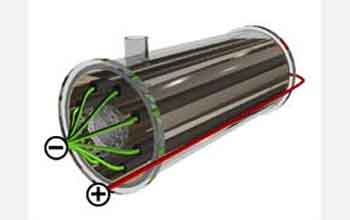News Release 04-021 - Video
Fuel-Cell Microbes' Double Duty: Treat Water, Make Energy
This material is available primarily for archival purposes. Telephone numbers or other contact information may be out of date; please see current contact information at media contacts.

This National Science Foundation animation schematically shows the anatomy of the single-chambered microbial fuel cell developed at Pennsylvania State University.
Credit: Trent L. Schindler / National Science Foundation
Video Transcript: Down the center of the microbial fuel cell’s single chamber runs the cathode, or positive electrode. It consists of a perforated plastic tube, which allows air to enter the fuel cell. Covering the tube is a layer of Nafion, a membrane through which protons may pass. A wire comes off the cathode to allow the circuit to be connected.
Eight graphite rods combine to serve as the anode, or negative electrode of the cell.
The anode and cathode are housed in a chamber into which wastewater flows.
Bacteria in the wastewater attach themselves to the anode rods and, by the chemistry of their metabolism, break down the organic matter in the wastewater. This releases electrons to the anodes and hydrogen protons into the solution. The protons (positive hydrogen ions) then pass through the proton exchange membrane of the cathode. At the cathode, oxygen from the air, the hydrogen ions coming through the membrane and the electrons coming down the circuit from the anode combine to create water.
Connecting the positive and negative electrodes, and placing an electrical load between them, would complete an electrical circuit. Meanwhile, the bacteria also remove up to 78 percent of organic matter as measured by biochemical oxygen demand, a key factor in the treatment of wastewater. (As the wastewater flows in, the treated effluent departs the chamber from a tube not shown.)

This video requires the free RealPlayer plug-in


